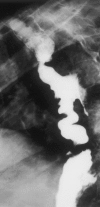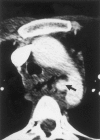Aortoesophageal fistula: value of in situ aortic allograft replacement
- PMID: 12894023
- PMCID: PMC1422695
- DOI: 10.1097/01.sla.0000080828.37493.e0
Aortoesophageal fistula: value of in situ aortic allograft replacement
Abstract
Purpose: The purpose of this report is to describe our experience in management of aortoesophageal fistulas (AEF) with special emphasis on the value of in situ aortic allograft replacement.
Patients: Nine patients presenting with AEF were observed between May 1988 and April 2002. There were 4 men and 5 women with a mean age of 54.3 years (range, 32-77 years). Six patients presented secondary AEF after aortic repair. Two patients presented primary AEF after rupture of an atherosclerotic aneurysm into the esophagus. In the remaining patient, AEF was caused by swallowing a fishbone. In 6 cases involving true AEF with a direct communication between the aorta and esophagus, massive exsanguinating hematemesis occurred. It was usually preceded by minor sentinel bleeding. Two patients presented esophagoparaprosthetic fistula (EPPF). One patient presented primary AEF that was contained by a large thrombus in the communication. The clinical picture in these 3 patients involved severe sepsis without hemorrhage.
Results: Two patients died as a result of massive hemorrhage before assessment and surgical treatment could be undertaken. One 77-year-old woman presenting EPPF refused to undergo surgery and died because of infection. The remaining 6 patients underwent surgical treatment with various outcomes. One man died during thoracotomy caused by exsanguinating hemorrhage. One woman presenting EPPF was treated by exclusion followed by ascending aorta to abdominal aorta bypass grafting, removal of the prosthesis, esophageal exclusion, and directed esophageal fistula. She died of infection. The other 4 patients were treated by in situ aortic allograft replacement. The damaged esophagus was repaired by using the Thal technique in 1 patient. In the remaining 3 cases subtotal esophagectomy was performed in association with cervical esophagostomy, ligation of the abdominal esophagus, gastrostomy, and jejunostomy. One patient died of sepsis during the first 24 hours after the operation. The other 3 patients underwent secondary esophagoplasty and survived with no further sign of infection. Mean duration of follow-up in the survivor group was 53 months (range, 15-95 months). Overall 6 patients, including 3 that did not undergo surgical treatment, died and 3 patients survived.
Conclusion: Our experience confirms that AEF is a rare but catastrophic disorder. In situ allograft replacement usually in association with subtotal esophagectomy appears to be an excellent salvage modality whenever emergency surgery is feasible.
Figures






Similar articles
-
Acute management of aortobronchial and aortoesophageal fistulas using thoracic endovascular aortic repair.J Vasc Surg. 2009 Nov;50(5):999-1004. doi: 10.1016/j.jvs.2009.04.043. Epub 2009 May 29. J Vasc Surg. 2009. PMID: 19481408
-
[Aorto-enteric fistulas].Srp Arh Celok Lek. 2001 Jul-Aug;129(7-8):183-93. Srp Arh Celok Lek. 2001. PMID: 11797448 Serbian.
-
Repair of aortoesophageal fistula after total aortic arch grafting.Interact Cardiovasc Thorac Surg. 2011 Apr;12(4):655-6. doi: 10.1510/icvts.2010.257501. Epub 2011 Jan 12. Interact Cardiovasc Thorac Surg. 2011. PMID: 21228040
-
Outcomes of thoracic endovascular aortic repair for aortobronchial and aortoesophageal fistulas.J Endovasc Ther. 2009 Aug;16(4):428-40. doi: 10.1583/09-2741R.1. J Endovasc Ther. 2009. PMID: 19702348 Review.
-
Aortoesophageal fistula caused by aneurysm of the thoracic aorta: successful surgical treatment, case report, and literature review.J Vasc Surg. 1999 Dec;30(6):1150-7. doi: 10.1016/s0741-5214(99)70056-x. J Vasc Surg. 1999. PMID: 10587402 Review.
Cited by
-
Aortoesophageal fistula and arch pseudoaneurysm after removing of a swallowed chicken bone: a case report of one-stage hybrid treatment.BMC Surg. 2018 Jan 11;18(1):3. doi: 10.1186/s12893-018-0335-1. BMC Surg. 2018. PMID: 29325526 Free PMC article.
-
Thoracic endovascular aortic repair in management of aorto-oesophageal fistulas: a case series.Eur Heart J Case Rep. 2020 Sep 9;4(5):1-6. doi: 10.1093/ehjcr/ytaa295. eCollection 2020 Oct. Eur Heart J Case Rep. 2020. PMID: 33204973 Free PMC article.
-
Dieulafoy's Lesion in the Esophagus Causing Gastrointestinal Bleeding: A Concise Review.J Community Hosp Intern Med Perspect. 2024 Nov 2;14(6):82-88. doi: 10.55729/2000-9666.1425. eCollection 2024. J Community Hosp Intern Med Perspect. 2024. PMID: 39839160 Free PMC article. Review.
-
Surgical approach for the treatment of aortoesophageal fistula combined with dual aortic aneurysms: a case report.J Cardiothorac Surg. 2013 Nov 4;8:206. doi: 10.1186/1749-8090-8-206. J Cardiothorac Surg. 2013. PMID: 24180498 Free PMC article.
-
A cure with successful staged treatment of aortoesophageal fistula.Gen Thorac Cardiovasc Surg. 2016 Jan;64(1):28-30. doi: 10.1007/s11748-013-0351-0. Epub 2013 Nov 29. Gen Thorac Cardiovasc Surg. 2016. PMID: 24293247
References
-
- BaulieuxJ, Durieux G. Anévrysme mycotique de l’aorte thoracique rompu dans l’œsophage: àa propos d’un cas opéré avec succèes. Chirurgie. 1982;108:72–77. - PubMed
-
- Bogey WM Jr, Thomas JH, Hermreck AS. Aortoesophageal fistula: report of a successfully managed case and review of the literature. J Vasc Surg. 1992;16:90–95. - PubMed
-
- Bruce CM, Paul VM, Ben EK. Successful salvage of an 8-month-old child with an aortoesophageal fistula. J Pediatr Surg. 1991;26:1394–1395. - PubMed
-
- Bullaboy CA, Derkac WM, Johnson DH, et al. False aneurysm of the aorta secondary to an esophageal foreign body. Ann Thorac Surg. 1985;39:275–276. - PubMed
-
- Cairols MA, Izquierdo LM, Barjau E, et al. Primary aorto-oesophageal fistula due to oesophageal carcinoma: report of a successfully managed case. Int Angiol. 2000;19:290–293. - PubMed
MeSH terms
LinkOut - more resources
Full Text Sources
Miscellaneous

